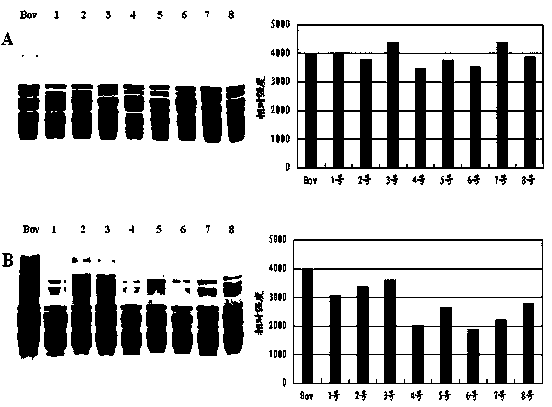Method for screening wheat varieties with low celiac sprue toxicity based on T cell epitopes
A celiac disease and epitope technology, applied in the food and biological fields, can solve the problems of high cost, time-consuming and laborious, and low glutenin extraction efficiency, and achieve the effect of simple operation method, simple operation, and clear and intuitive detection results.
- Summary
- Abstract
- Description
- Claims
- Application Information
AI Technical Summary
Problems solved by technology
Method used
Image
Examples
Embodiment 1
[0021] Example 1: Screening of celiac disease-causing T cell epitopes in different wheat varieties.
[0022] The whole screening process includes extraction of wheat gluten protein, SDS-PAGE of gluten protein combined with PageBlue TM Identification of staining, based on immunoblotting of mAbs against T cell epitopes. The specific implementation process includes the following steps.
[0023] 1. Extraction and identification of gluten protein.
[0024] Eight wheat varieties were selected, Nos. 1-8 were Yanshi 16, Neixiang 184, Zhengzhou 941, Yanzhan 893, Xiaoyan 54, Xinhan 1, Zhengnong 16, Yunong 015 and a control variety Bovictus. Gluten protein is extracted after flour.
[0025] Gluten protein was extracted using a 50% isopropanol / DTT two-step method. Select wheat kernels of various varieties and grind them into fine powder with a mortar, pour them into centrifuge tubes, and use them to extract gluten protein. For the first extraction, extract with 50% (v / v) isopropanol,...
PUM
 Login to View More
Login to View More Abstract
Description
Claims
Application Information
 Login to View More
Login to View More - R&D
- Intellectual Property
- Life Sciences
- Materials
- Tech Scout
- Unparalleled Data Quality
- Higher Quality Content
- 60% Fewer Hallucinations
Browse by: Latest US Patents, China's latest patents, Technical Efficacy Thesaurus, Application Domain, Technology Topic, Popular Technical Reports.
© 2025 PatSnap. All rights reserved.Legal|Privacy policy|Modern Slavery Act Transparency Statement|Sitemap|About US| Contact US: help@patsnap.com


